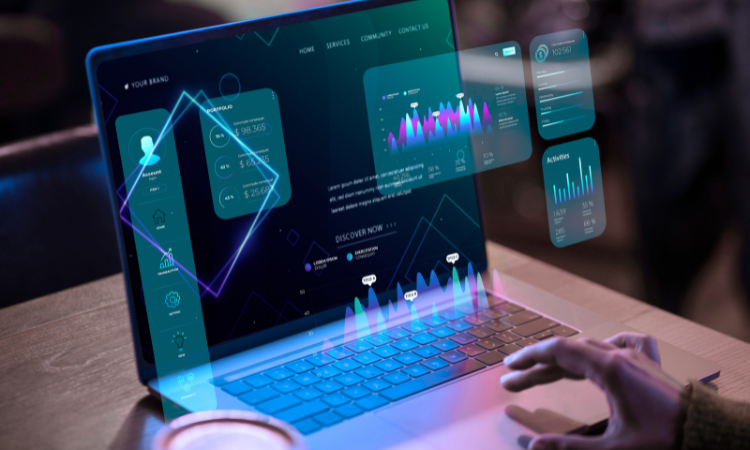Ever read a review that says “it’s fine” — and wondered if that meant actually fine, or about to churn?
Welcome to the age of nuance, where what customers say isn’t always what they mean — and what they mean is often buried in tone, hesitation, or what they don’t say at all. The companies winning in today’s market aren’t just listening to customers — they’re decoding them. They’re spotting frustration before it turns into an unsubscribe. They’re recognizing delight hiding behind a one-line chat. They’re anticipating needs before they’re ever voiced.
It’s no longer enough to collect data. You need to understand it with precision, speed, and empathy.
According to Salesforce’s State of Sales report, the single greatest challenge for organizations is staying ahead of these evolving needs while leveraging the deluge of customer feedback for strategic decision-making.
And that’s where AI customer insights comes in.
Artificial Intelligence isn’t just analyzing responses — it’s reading between the lines. By uncovering hidden patterns, emotions, and intent, customer insights analytics help you move from reaction to anticipation, from data overload to decision clarity.
In this blog, we’ll break down how AI is reshaping customer understanding — and how you can leverage it to prioritize better, personalize faster, and grow smarter.
TL;DR
- Customer insights reveal the why behind customer behavior and enable smarter, faster decisions — especially when powered by AI.
- AI helps surface nuanced signals and trends from feedback data, turning scattered inputs into focused business improvements.
- Behavioral, sentiment, demographic, intent, journey, and competitive insights help decode what customers do, feel, and expect.
- From real-time alerts to predictive analytics, AI empowers businesses to respond faster, personalize deeper, and anticipate needs better.
- Focusing on high-impact insights, breaking silos, and using role-based dashboards ensures your AI findings turn into cross-team action.
- Zonka Feedback is an AI insights tool that helps you identify themes, detect emotion, spot churn signals, and automate responses — all from one place. You can get early access to its latest AI capabilities or schedule a demo and start making customer decisions with confidence.
Decode Customer Feedback at Scale with AI-Powered Insights🔍
Quickly make sense of your customer data with AI-powered insights. Use Zonka Feedback to uncover themes, sentiments, and trends effortlessly.

What Are Customer Insights?
Customer insights aren’t just summaries of feedback — they’re the aha moments that reveal what your customers value, what’s frustrating them, and why they behave the way they do.
Whether it’s noticing that checkout drop-offs spike on mobile or spotting recurring mentions of “confusing setup” in reviews, these insights give you the why behind the what. They’re not just about hearing your customers — they’re about understanding them deeply enough to act decisively.
But turning scattered observations into clear, actionable insights? That’s the real challenge. Traditionally, businesses relied on manual analysis — poring over survey results, combing through support tickets, and trying to connect the dots. It’s slow, inconsistent, and nearly impossible to scale.
This is where AI for customer insights creates a breakthrough. With the ability to analyze vast volumes of behavioral and qualitative data in seconds, AI extracts hidden patterns, classifies emotions, and reveals the underlying drivers behind customer decisions. It shifts teams from reactive guesswork to strategic clarity.

Why These Customer Insights Matter?
Each type of insight adds a crucial layer to the story your customers are telling you. Together, they reveal what's working, what's not, and where meaningful improvements can be made.
The best part?
With AI, there’s no need for guesswork. It quickly collects and analyzes insights across multiple channels, empowering you to make data-driven decisions.
Customer insights do more than address issues—they help you identify market trends, recognize pain points, and uncover growth opportunities. For example, if there’s a rising demand for faster shipping or eco-friendly packaging, AI-driven insights allow you to adapt your strategy and stay ahead of the competition.
AI provides clear, actionable themes derived from real customer experiences. It uncovers connections that traditional methods often overlook, enabling you to make decisions that have a lasting impact.
With AI-driven insights, you shift from responding to problems to proactively shaping customer experiences. It’s not about deciphering feedback—it’s about knowing exactly where to focus for meaningful change.
Understanding Consumer Behavior with Key Customer Insights
Every interaction your customers have with your brand holds a key insight. These insights reveal what they want, how they feel, and where you can improve. Let’s break it down into the key types of insights that help you truly understand your customers.
Behavioral Insights
Behavioral insights reveal how your customers interact with your brand, helping you understand their actions and identify opportunities to enhance their journey.
→ Are they spending time on your product pages but not buying?
→ Are they abandoning their carts halfway through checkout?
By asking these questions, you get valuable insights that help you understand their journey, highlighting where they engage and where they face challenges, so you can take action to improve their experience.
For example, if customers often leave during the payment process, it could mean the system feels clunky or untrustworthy.
Sentiment Insights
Sentiment insights provide a window into how your customers feel—whether they're happy, frustrated, or neutral.
AI enhances this understanding by analyzing customer feedback in depth, revealing the emotions driving their responses. By uncovering these sentiments, businesses can identify key concerns, improve customer satisfaction, and create experiences that genuinely resonate with their audience.
Demographic Insights
Demographic insights offer a clearer picture of who your customers are.
They provide critical information such as age, location, income, and other defining characteristics. With this knowledge, businesses can segment their audience more effectively and tailor strategies that speak directly to distinct groups.
For example, you might notice a product appeals to customers under 30 but not to older demographics. This insight enables you to refine your messaging or adjust targeting efforts to connect with the right audience more effectively.
Intent Insights
Intent insights provide the answer to a crucial question: Why are your customers engaging with your brand?
These insights reveal the underlying purpose behind customer actions—whether they're browsing, seeking assistance, or ready to make a purchase. By using sentiment analysis tools that gauge intent intent, businesses can tailor their responses, delivering the right solutions, recommendations, and support at precisely the right moment.
Focusing on intent shifts the approach from reactive to anticipatory, allowing companies to create experiences that not only drive satisfaction but also build loyalty and deliver measurable results.
Competitive Insights
Competitive insights provide a clear view of how your brand compares to its competitors.
These insights highlight areas where your brand excels and where it may lag behind, whether in pricing, quality, or customer experience. By understanding your market position, you can pinpoint opportunities for improvement and direct your efforts toward strategies that differentiate you.
Companies that leverage competitive insights do more than track trends—they lead by addressing gaps and amplifying their strengths.
Journey Insights
Journey insights provide a comprehensive view of how customers navigate your processes—from their first interaction to post-purchase feedback.
These insights track each step of the customer journey, highlighting smooth interactions as well as areas where friction occurs. By understanding these touchpoints, businesses can identify opportunities for improvement, refine processes, and create a seamless experience that fosters trust and loyalty.
For example, if a significant number of customers abandon their purchase at the shipping details stage, this signals the need to reassess the clarity or flexibility of that step, ensuring customers can complete their journey without frustration.
Why AI Customer Insights Are Critical for Business Growth?
Collecting feedback is easy. Understanding it—and acting on it at scale—is what separates market leaders from the rest. Below are six common barriers that prevent businesses from fully leveraging customer insights, and how AI transforms each into an opportunity for smarter, faster decisions.
a. Manual Analysis Is Time-Consuming and Inefficient
Manual analysis of customer feedback is a drain on time and resources. For Sophia, a customer experience manager at a fast-growing e-commerce company, it meant spending hours each week reviewing surveys, support tickets, and social media comments.
Her team faced the daunting task of sorting through thousands of responses, searching for trends, and preparing reports. It was a constant race against the clock—one that they often lost, falling behind on deadlines. The process wasn’t just slow; it was riddled with errors, causing key insights to slip through the cracks.
That’s when AI made all the difference.
💡 AI eliminates this bottleneck by automating data analysis. Instead of manually sifting through thousands of comments, AI tools use customer insights analytics to instantly group feedback into actionable themes. For instance, AI's efficiency in transforming complex tasks is proven by its use in the pharmaceutical industry, where it has reduced drug discovery timelines by over 50%.
b. Disconnected Feedback Across Multiple Channels
Customer feedback lives everywhere—emails, social media, surveys, and call centers. But when these channels operate in silos, the insights remain fragmented.
Without a unified view, teams miss critical connections, making it harder to identify patterns or address root causes. The result? Valuable opportunities to improve the customer experience slip through the cracks.
💡 AI customer analytics platforms consolidate data from all channels into a single, cohesive view. This integration enables businesses to efficiently act on feedback and foster innovation. It’s no surprise that 67% of top-performing companies already use Generative AI development services to enhance their products and services.
c. Lack of Actionable Insights
Customer satisfaction scores are dropping, but why? Traditional feedback analysis often highlights broad trends like “poor service” or “delayed responses,” leaving teams without clear direction.
The lack of actionable insights forces guesswork, leading to missed opportunities and wasted resources. Without precision, businesses risk investing in solutions that fail to address the real problems.
💡 AI bridges this gap by uncovering specific, actionable insights. For example, sentiment analysis might reveal that forty percent of negative feedback stems from dissatisfaction with the returns process. With organizations increasingly focused on differentiation, it’s no wonder that 46% of executives cite creating unique products and services as a top priority when investing in AI.
d. Difficulty in Scaling Feedback Analysis
A global apparel brand saw its feedback volume skyrocket after expanding into multiple regions. Reviews flooded in from social media, surveys, and customer service channels, each highlighting different issues—product quality, shipping delays, and sizing inconsistencies.
The team, overwhelmed by the sheer scale, struggled to categorize and prioritize the feedback. Regional managers relied on spreadsheets and manual methods, which couldn’t keep up with the growing complexity. Critical insights slipped through the cracks, delaying key improvements and frustrating customers.
Scaling feedback analysis isn’t just about managing volume—it’s about ensuring every customer voice is heard, no matter how big the business gets.
💡 AI is designed to handle high-volume scenarios with ease. It processes massive datasets simultaneously, ensuring consistency and precision. For instance, Verizon used AI to analyze millions of customer interactions, enabling the company to identify and resolve issues like network disruptions more efficiently.
e. Lack of Real-Time Feedback Processing
Delays in processing customer feedback can create bigger issues than businesses realize. Without real-time insights, opportunities to address concerns slip through the cracks. Trust erodes, reputations suffer, and small problems escalate into larger challenges.
Acting too late means missing the chance to turn a dissatisfied customer into a loyal advocate. And in a world where customer expectations are higher than ever, that’s a risk no business can afford to take.
💡 AI enables real-time analysis, allowing organizations to act on feedback as it happens. AI tools alert the team instantly, enabling them to deploy support resources or update instructions before the issue escalates.
f. Inability to Detect Patterns and Trends
At a busy retail outlet, Sarah, the store manager, faced a recurring challenge: customer complaints about long checkout times.
Customers voiced their frustrations across multiple channels—surveys, online reviews, and social media posts—highlighting the persistent issue of checkout delays. Yet, with feedback dispersed across these platforms, Sarah’s team struggled to synthesize the insights and identify the underlying cause of the problem. The noise of fragmented data overshadowed the actionable insights needed to drive meaningful change.
💡 With AI for customer insights, you can detect recurring patterns like “long wait times” or "slow response" in support interactions during peak hours. These connections make it easier to take action like proactively adjusting staffing levels, or improving operational efficiency before issues escalate.
How Can Businesses Leverage AI for Customer Insights?
AI has shifted from being a helpful tool to becoming a business essential that empowers large organizations to understand their customers better, respond faster, and make decisions that truly matter. By strategically leveraging AI, they can transform customer feedback into meaningful action.
→ Act on Feedback Before It’s Too Late
Customer feedback is more than input—it’s an opportunity to address issues and strengthen trust.
Timing is critical. Swift responses not only resolve problems but also demonstrate to customers that their concerns matter. With AI-powered real-time monitoring, businesses can identify issues—such as delayed shipping—before they escalate. Proactive action transforms potential frustration into loyalty, reinforcing your commitment to customer satisfaction.
→ Decode What Your Customers Are Really Saying
Understanding your customers goes beyond hearing their words—it’s about uncovering how they feel. Decoding these emotions is essential for identifying and addressing what truly matters.
AI-powered sentiment analysis adds depth to this understanding. It captures nuances like sarcasm and mixed emotions that traditional methods often miss.
Consider a hospitality chain using sentiment analysis to review customer feedback. If "rude staff" consistently appears in negative reviews, the insight pinpoints a critical area for improvement, such as enhancing staff training and customer service. This level of precision helps businesses prioritize actions that drive meaningful change.
→ Anticipate Customer Needs Before They Ask
The true measure of customer-centricity isn’t just solving today’s problems—it’s predicting tomorrow’s needs.
AI-powered predictive analytics give businesses the ability to detect patterns in customer behavior and foresee potential issues before they arise. For instance, if the system identifies a customer at risk—perhaps due to declining engagement or frequent complaints—it enables proactive intervention. A well-timed personalized message, exclusive offer, or added support can make all the difference in retaining loyalty and deepening the relationship.
→ Make Every Customer Interaction Personal
Consider how Netflix consistently recommends shows and movies that match your interests. This isn’t coincidence—it’s AI at work.
By analyzing viewing habits, preferences, and patterns, Netflix creates a highly personalized experience. It’s more than convenience; it’s about making users feel understood and valued.
Your business can achieve the same level of personalization. With AI, you can analyze customer behavior to deliver tailored experiences, solutions, and recommendations. This approach builds trust, fosters loyalty, and encourages repeat engagement—driving long-term success.

→ Transform Data Overload Into Clear Action
Customer data is a powerful resource for driving growth, satisfaction, and loyalty. Yet, without the right tools, it can quickly become an unmanageable flood of information.
AI changes the game. It filters through massive datasets, delivering clear, actionable insights that uncover patterns and trends critical to growth. For example, a SaaS company might identify that simplifying its onboarding process dramatically boosts user retention—insights that lead to immediate, strategic improvements.
By harnessing AI, businesses can go beyond collecting feedback, using data to drive decisions with clarity and confidence.
How to Maximize the Value of AI Customer Insights?
AI customer insights are a powerful resource, but their true value lies in how effectively you act on them. To drive meaningful impact, focus on what matters most, foster collaboration across teams, and remain agile in responding to customer needs.
Focus on What Matters Most
During a busy retail season, Raj, a store manager, noticed a recurring theme in customer feedback: frequent mentions of "billing errors" across multiple channels. While it was just one issue among many, AI highlighted its significance due to the volume and impact of the complaints.
By addressing this pain point immediately, Raj not only resolved a critical issue but also significantly improved overall customer satisfaction. This targeted approach underscores the importance of prioritizing insights that drive the greatest value for both the business and its customers.
Break Down Silos: Share Insights Across Teams
When customer insights remain siloed, opportunities are lost. Sharing insights across teams—product, marketing, and support—ensures they translate into impactful actions.
For instance, if AI uncovers a strong demand for "faster shipping," the product team can focus on optimizing logistics, while the marketing team highlights this improvement in campaigns. By aligning on insights, teams can execute seamlessly, driving results that resonate with customers.
Stay Ahead of Evolving Trends
Businesses that closely monitor customer data are better positioned to stay ahead of emerging trends—but catching the early signals is key.
When AI identified a growing demand for "eco-friendly packaging," the marketing team seized the opportunity to stand out in the market. Within weeks, they introduced a new packaging line that directly addressed customer concerns, earning a competitive advantage well before others in the industry responded.
Turn Customer Data into Decisions with Zonka Feedback’s AI Customer Insights
No matter the size of your business or the channels you use to collect feedback, one truth holds: data alone doesn’t drive growth — insight does. Zonka Feedback helps you bridge that gap with AI-powered customer insights. Whether you're trying to understand customer frustration in support tickets, detect patterns in product feedback, or discover what's really driving churn, Zonka Feedback equips you with the clarity to act decisively — and quickly.
Here’s how it elevates customer insights:
- AI Smart Summaries: Automatically condense long-form feedback — like survey responses, open-text reviews, or interview transcripts — into concise, human-readable summaries. For instance, instead of reading 200 feedback entries on your new onboarding flow, get one summary that pinpoints the exact friction points and highlights recurring praise.
- Sentiment & Emotion Analysis: Go beyond surface-level sentiment as the AI feedback intelligence tags responses as positive, neutral, or negative and detects deeper emotional tones like anger, delight, confusion, or frustration. This gives teams access to emotion detection and context they need to make empathetic decisions.
- Themes & Entity Recognition: The system automatically groups feedback into themes like "Billing Issues," "UX Confusion," or "Feature Requests," while also detecting specific entities such as “Android,” “iPhone,” “checkout page,” or “support agent Anna.” This level of specificity allows teams to connect sentiment to exact experiences.
- AI Trends, Correlations & Real-Time Insights: Spot issues that impact CSAT, NPS, or churn in real time. You can slice feedback by custom attributes like region, product line, customer type, or even user role — and view shifts over time. For instance, a spike in negative sentiment from Enterprise users in Europe about the new dashboard could trigger immediate workflow alerts and a design team sprint.
- AI Feedback Copilot: Ask your data anything. Want to know “What’s causing low NPS in Q2 for mobile users in North America?” Zonka’s upcoming conversational insight engine will let you query feedback the way you’d ask a teammate — and get structured answers.
- Role-based Dashboard: It equips teams with role-based dashboards that surface the most relevant insights for each function. Product teams can track feature-level feedback, CX teams can monitor sentiment trends, and marketing can view campaign perception — all in one place. This focused visibility ensures faster, more aligned decision-making across departments.
- Built-in Workflows: Its automated workflows helps in closing the loop fast. When AI detects issues—like a spike in negative sentiment or a potential churn signal—it can instantly trigger alerts, assign tasks to the right team, or initiate follow-up surveys. These automated workflows transform insights into real-time actions, ensuring your response is as fast and relevant as the feedback itself.
Conclusion
AI-powered customer insights aren’t just a technology upgrade — they’re a mindset shift. When you stop guessing and start understanding your customers at a deeper level, every decision becomes sharper, faster, and more customer-aligned.
Whether it’s uncovering silent churn signals, prioritizing the right product fix, or launching messaging that resonates — AI customer insights help you move from reactive to proactive. And in today’s fast-changing landscape, that’s the competitive edge every business needs.
Zonka Feedback is a customer experience platform that makes this transformation easy. With its AI Feedback Intelligence, you can automatically uncover sentiment, emotion, intent, themes, and actionable patterns from every channel — at scale. From smart summaries and real-time alerts to role-based dashboards and seamless workflows, it’s built to power smarter decisions across your organization.
Want to experience the future of customer insights? Get early access to Zonka Feedback’s newest AI capabilities or sign up for a 14-day free trial to explore the current suite of feedback and analytics features. Start turning raw feedback into real business impact — instantly!
Frequently Asked Questions (FAQs)
Q.1. What is AI Insights?
AI insights are the actionable insights you gain when artificial intelligence analyzes customer feedback, behaviors, and interactions. They reveal patterns, sentiments, and trends, helping you make smarter decisions to improve customer experiences and drive business growth.
Q.2. How to Use AI for Consumer Insights?
You can use AI for data analysis by examining surveys, social media, and reviews. It identifies patterns, predicts behaviors, and uncovers sentiments, enabling you to personalize experiences, target marketing efforts, and solve problems with precision.
Q.3. Why are AI-driven customer insights important for businesses?
AI-driven insights enable businesses to:
- Act quickly on feedback to address concerns in real time.
- Improve customer satisfaction by solving issues proactively.
- Identify new opportunities and untapped customer needs.
- Address recurring challenges with precision and focus.
These insights also empower data-driven decision-making, ensuring businesses stay competitive and agile in a rapidly evolving market.
Q.4. How Is AI Used in Customer Service?
AI improves customer service by automating responses with chatbots, analyzing sentiment for better communication, and giving agents real-time insights. It helps you resolve issues faster, provide personalized solutions, and keep your customers satisfied.
Q.5. How AI Can Analyze Customer Reviews?
AI processes your customer reviews using natural language processing to detect sentiments, spot recurring themes, and highlight critical issues. It helps you understand feedback at scale, prioritize changes, and enhance your customer experience effectively.
Q.6. Can AI help predict customer behavior?
Yes, AI can analyze historical data to predict customer behavior, preferences, and needs. Predictive analytics helps businesses anticipate customer actions, reduce churn, and improve customer lifetime value through targeted strategies.











